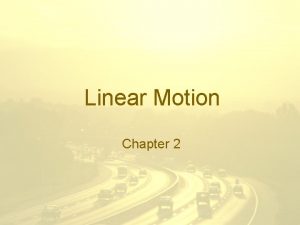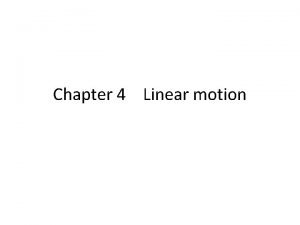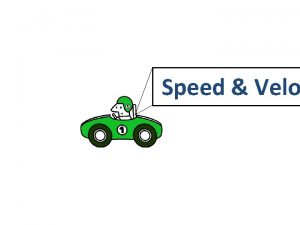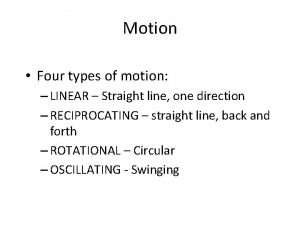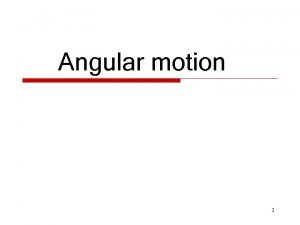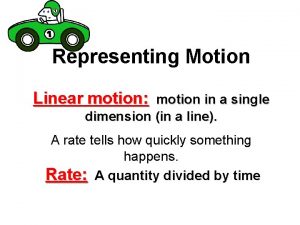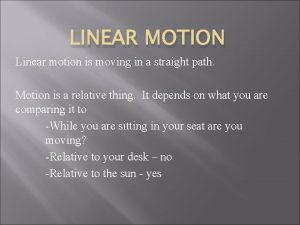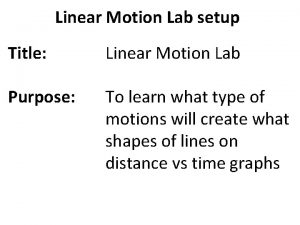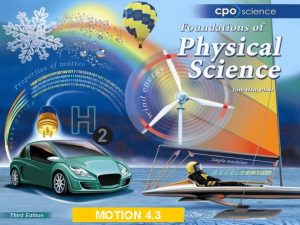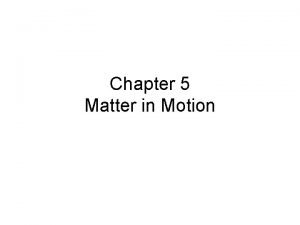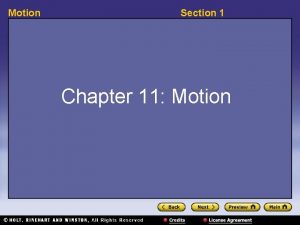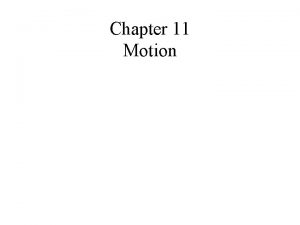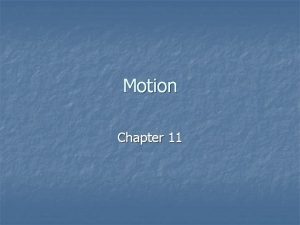Chapter Four Linear Motion Linear Motion Why is
























- Slides: 24

Chapter Four Linear Motion

Linear Motion �Why is it fair to say that everything moves? �An object is moving if its position relative to a fixed point is changing. �Unless stated otherwise, when we discuss speeds, it is with respect to the surface of our Earth

Speed �Galileo was the first to measure speed by considering the distance covered and the time it takes �Speed is how fast an object is moving Speed = distance time

OYB If a cheetah can maintain a constant speed of 25 m/s, how far will it travel in 10 seconds? In one minute?

Speed �Does your car always move at the same speed? �No, looking down at your speedometer will give you instantaneous speed, but that would not be completely accurate to calculate based on �Average speed is more of what we care about, especially when planning a trip, etc.

Average Speed �Average speed is the total distance covered divided by time Average speed covered = total distance time interval

OYB If your odometer reads zero at the beginning of a trip and 35 km a half hour later, what is your average speed? If your average speed is 80 km/hr on a four-hour trip, what distance do you cover?

Velocity �In everyday language, we use the words velocity and speed interchangeably. �What is the difference? �Speed is a description of how fast an object moves, velocity is how fast and in what direction it moves.

Velocity �Constant velocity means both constant speed and direction. ◦ OYB: Can a car going in a circle have constant velocity? �Changing velocity is where either speed, direction, or both is changing. �OYB: what three controls in your can change the car’s velocity?

Acceleration �When we are interested in knowing the rate of change in velocity, we are interested in acceleration �Acceleration is the rate at which velocity is changing. Acceleration = change of velocity time interval a= v t

Acceleration �What are some examples where we are used to this concept? �What does “good acceleration” in a car mean? �In physics, acceleration applies to both increases in speed and decreases in speed

Acceleration �Acceleration also applies to changes in direction �What was the definition of acceleration? �Acceleration is also a vector quantity because it is directional �http: //www. physicsclassroom. com/mm edia/kinema/acceln. cfm

Free Fall �Do items accelerate as they fall? �Would you catch a quarter dropped off the top of the roof here? What about one from the Empire State Building? �A quarter may not be able to cause much damage, but if a 50 gram bolt fell from the Empire State building, it would reach 250 mph, a fatal shot to the head

Free Fall �What affects a falling object? �Free fall is when an object is moving under the influence of only gravity. (No wind resistance, etc) Acceleration = 10 m/s 1 s �Should be written in m/s 2 the second occurs twice, once for the unit of speed and again for the time interval during which speed changes.

Free Fall �The acceleration of an object in free fall is approx 10 m/s 2 �It is customary to use the letter g to represent the acceleration due to gravity �When total accuracy is required, use of 9. 8 m/s 2 should be used �Instantaneous speed of an object falling from rest = acceleration x elapsed time v=gt

OYB �What would the speedometer reading on a falling rock be 4. 5 seconds after it drops from rest? �How about 8 seconds after it is dropped?

Rising Objects �What about an object that is thrown straight up? �We know the object is accelerating because its velocity is changing �Acceleration must be 10 m/s 2 downward the entire time, whether the object is moving upward or downward.

Free Fall: Distance �How fast something moves is different from how far it moves Elapsed Time (s) Instantaneous Speed (m/s) Distance Fallen (m) 0 0 0 1 10 5 2 20 20 3 30 45 4 40 80 5 50 125 t 10 t ½gt 2

Distance �These equations apply to any object whose initial speed is zero, like a car �Velocity v = at �Distance d = ½at 2 �OYB: An apple drops from a tree and hits the ground in one second. What is its speed upon striking the ground? What is its average speed during the one second? How high above the ground was the apple when it first dropped?

Speed vs. Time for a Freely Falling Object

Distance vs. Time for a Freely Falling Object

Air Resistance �What would drop faster, a coin or a feather? �Air resistance noticeably slows the motion of things with large surface areas like falling feathers or pieces of paper, but air resistance less noticeably affects the motion of more compact objects like stones and baseballs. http: //www. youtube. com/watch? v=AVqy. Dn. Zx 0 A

Review �How fast? ◦ v = gt �How Far? ◦ d = ½gt 2 �How ◦a= quickly how fast changes? v/t

Homework: Due in Notebook �Pages 63 -67 �#20, 22, 25, & odd questions 27 -49
 Hey hey bye bye
Hey hey bye bye Don't ask why why why
Don't ask why why why Chapter 2 motion section 1 describing motion answer key
Chapter 2 motion section 1 describing motion answer key Measuring motion
Measuring motion Section 1 describing motion worksheet answer key
Section 1 describing motion worksheet answer key Conceptual physics chapter 3 linear motion
Conceptual physics chapter 3 linear motion Chapter 2 linear motion
Chapter 2 linear motion Chapter 4 linear motion
Chapter 4 linear motion Chapter 4 test linear motion answer key
Chapter 4 test linear motion answer key Chapter 4 linear motion
Chapter 4 linear motion Shapes with four sides and four corners
Shapes with four sides and four corners Four eyes skin assessment
Four eyes skin assessment Chapter 2 representing motion assessment answers
Chapter 2 representing motion assessment answers Why must the artisans hurry to the duke’s palace
Why must the artisans hurry to the duke’s palace Qm for windows
Qm for windows Type of range of motion
Type of range of motion Simple harmonic motion equation of motion
Simple harmonic motion equation of motion An object in motion stays in motion
An object in motion stays in motion Chapter 1 lesson 2 describing motion answer key
Chapter 1 lesson 2 describing motion answer key Section 1 describing motion
Section 1 describing motion Why-why analysis
Why-why analysis Why do you cry willie why do you cry
Why do you cry willie why do you cry Does this table represent a function why or why not
Does this table represent a function why or why not Does the table represent a function why or why not
Does the table represent a function why or why not Why or why not
Why or why not






